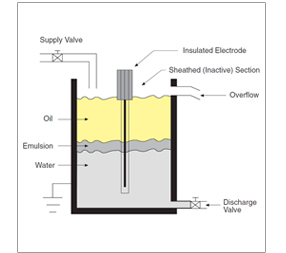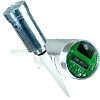Level Measurement
Introduction to Level Measurement
Integral to process control in many industries, level measurement sensors fall into two main types. Point level measurement sensors
are used to mark a single discrete liquid height–a preset level condition. Generally, this type of sensor functions as a high alarm,
signaling an overfill condition, or as a marker for a low alarm condition. Continuous level sensors are more sophisticated and can
provide level monitoring of an entire system. They measure fluid level within a range, rather than at a one point, producing an analog
output that directly correlates to the level in the vessel. To create a level management system, the output signal is linked to a
process control loop and to a visual indicator.
OMEGA Engineering offers a wide range of
level sensors in Singapore.

Level Interface Detection
Learn more about Level Measurement
What is a Float Switch?
In these point level sensors, a magnetic float moves with the liquid surface, actuating a hermetically sealed "reed switch"
in the stem. The simple, low-maintenance design installs readily; minimizes shock, vibration, and pressure; and works with a
variety of media. The reed switch can be single pole, single throw (SPST) or single pole, double throw (SPDT).
Non-Contact Ultrasonic Sensors for Level Measurement
These sensors incorporate an analog signal processor, a microprocessor, binary coded decimal (BCD) range switches, and an output
driver circuit. Transmit pulses and a gate signal from the microprocessor route through the analog signal processor to the sensor,
which sends an ultrasonic beam to the liquid surface. The sensor detects the echo from the surface and routes it back to the microprocessor
for a digital representation of the distance between the sensor and the surface level. Through constant updating of received signals,
the microprocessor calculates averaged values to measure liquid level.
With a continuous sensor, the microprocessor converts the averaged value to an analog 4 to 20 mA signal linear with the liquid level.
When the echo from the level does not return to the sensor within 8 seconds, the output signal from the system drops below 4 mA,
indicating a low-level condition or empty pipe. With a point sensor, the microprocessor compares the averaged value with the BCD switch
setting and energizes an output relay for either high or low level indication. A signal loss exceeding 8 seconds de-energizes the relays
and restores their original state. The electronics incorporate a half-second delay that minimizes surface turbulence effects.
Contact Ultrasonic Sensors for Level Measurement Applications
A low-energy ultrasonic device within these sensors measures liquid level at a certain point. Consisting of a field-mounted sensor and
integral solid state amplifier, contact ultrasonic sensors have no moving parts and require no calibration. Typically, they are equipped
with terminal blocks for connection of a power source and external control devices. The ultrasonic signal crosses a one-half inch gap in
the sensor, controlling relay switches when the gap contains liquid. The sensing level is midway along the gap for horizontally mounted
sensors, at the top of the gap for vertically mounted sensors. As liquid falls below this level, the ultrasonic signal attenuates and
ultimately switches the relay to its prior state.
These sensors are used in vessels or pipes to automatically operate pumps, solenoid valves, and high/low alarms. Two would be required to
fill and empty tanks, and to meter liquid volumes. Compatible with most liquids, they are unaffected by coatings, clinging droplets, foam,
and vapor. However, highly aerated liquids and liquids viscous enough to clog the sensor gap may cause problems.
Capacitance Level Sensors
Like ultrasonic sensors, capacitance sensors can handle point or continuous level measurement. They use a probe to monitor liquid level
changes in the tank, electronically conditioning the output to capacitive and resistive values, which are converted to analog signals.
The probe and the vessel wall equate to two plates of a capacitor, the liquid to the dielectric medium. Because the signal emanates
from level changes alone, material build-up on the probe has no effect. Non-conductive fluid vessels may dictate dual probes or an
external conducting strip.
The probe, which can be rigid or flexible, commonly employs conducting wire insulated with PTFE. Using stainless steel as the probe's
base metal provides the extra sensitivity needed for measuring liquids that are non-conductive, granular, or low in dielectric properties
(dielectric constant less than 4). Flexible probes must be used when there is insufficient clearance for a rigid probe, or in applications
that demand very long lengths. Rigid probes offer higher stability, especially in turbulent systems, where swaying of the probe can
cause signal fluctuations.
Choose the right Level Measurement Equipment for your application
 Non-Contact Ultrasonic Level Sensors
Non-Contact Ultrasonic Level Sensors
With power and programming options, RS-232 or RS-485 communications capability, pushbutton calibration, and temperature-compensated
signaling, The LVU40 Series ultrasonic level sensor bring
another dimension of flexibility to continuous non-contact liquid level measurement. Highly accurate over their entire range of 0.3 to 18.3 m (1 to 60'),
they incorporate filtering that virtually eliminates false echoes from peripheral obstructions. In conjunction with a PLC (programmable
logic controller) or an OMEGA CNi Series controller, they can be used for point level measurement.
 Radar Level Transmitters
Radar Level Transmitters
In applications requiring non-contact measurement of liquid levels, the affordable LVRD500
radar transmitter is the logical extension of ultrasonic sensors. They are ideal where vapor, dust, or a foaming surface prevents
ultrasonic measurement. Their radar sensor uses microwave pulse technology to track target liquids from the antenna tip to the bottom of a tank.
This advanced "echo marker" signal processing provides a reliable continuous pulse shape unaffected by environmental
conditions. RS-232 and RS-485 models are available.
The pocket infrared thermometers are extremely
compact. They are normally small enough to be carried in a shirt pocket.
 Dry Material Rotary Paddle Level Switch
Dry Material Rotary Paddle Level Switch
Compatible with many granular, pelletized, and powdered substances, LVD-800 Series
rotary paddle level switchese use patented magnetic
technology that makes fail-safe bin, hopper, silo, and tank monitoring a reality. A self-diagnosing microcontroller constantly
monitors rotation of the shaft and motor mounting plate, reacting immediately to material presence and to mechanical or electrical
failure. Magnetic sensing avoids the fouling problem inherent to optical systems. The twist-on cover does away with bolts,
there are 2 conduit entrances, and most models have a status light. High-temperature models are rated to 399°C (750°F).
A is a small low cost
infrared sensor. They are unique in that they are self-powered and produce an output that mimics a thermocouple sensor.
 Capacitance Measurement Probes
Capacitance Measurement Probes
Able to withstand high temperatures and pressures, and impervious to many corrosives, LV3000/4000 Series
level measurement probes give reliable
continuous level measurements in difficult applications. Appropriate for liquids, pastes, and some solids–whether conductive
or non-conductive–they have no moving parts and are easy to install. After rectifying and filtering incoming power, generating a
radio frequency signal, and calculating changes in current, the electronic circuitry produces a 4 to 20 mA 2-wire output signal
proportional to the process level. Convenient zero and span adjustments let the user factor in variables such as media type,
vessel dimensions, rod length, and installation position. If the stainless steel probe will be used near a conductive vessel
wall, a PTFE-insulated model will prevent short circuiting.
Frequently Asked Questions
Level Measurement Sensor Selection
Make sure you have the answes to the following key questions before selecting a level meter, controller on any other level measurement instrument:
1. Are you measuring a liquid or solid?
2. What are the application's temperature and pressure ranges?
3. Is point level or continuous measurement required?
4. What level measurement range do you need?
5. Is the measured material electrically conductive?
6. Will the material coat or build up on surfaces?
7. Does turbulence, foam, or vapor occur at the surface of the liquid?
8. Will you need contact or non-contact level measurement?
9. What kind of output do you need–analog, relay, digital display, etc.?
Shop for Level Sensor in Singapore
The OMEGA Engineering Singapore office services all of Southeast Asia and Taiwan. We have Application Engineers and Sale Support Staff ready to assist
you with your technical questions, quotations and orders. A one-stop source for process measurement and control based in the heart of Singapore.
We provide support through web chat, e-mail and telephone. Come visit our office; view our
contact page for location details.
Level Measurement Sensors | Related Products
↓ View this page in another language or region ↓

 Non-Contact Ultrasonic Level Sensors
Non-Contact Ultrasonic Level Sensors
 Radar Level Transmitters
Radar Level Transmitters
 Dry Material Rotary Paddle Level Switch
Dry Material Rotary Paddle Level Switch
 Capacitance Measurement Probes
Capacitance Measurement Probes

 Medição de Nível
Medição de Nível
 Mesure de Niveau
Mesure de Niveau
 Medición de Nivel
Medición de Nivel
 Medición de Nivel
Medición de Nivel
 Level Measurement
Level Measurement
 Niveaumåling
Niveaumåling
 Mesure et Détection de Niveau
Mesure et Détection de Niveau
 Füllstandmessung
Füllstandmessung
 Indicatori e misuratori di livello
Indicatori e misuratori di livello
 Level Measurement
Level Measurement
 Sensores de Nivel y Medición
Sensores de Nivel y Medición
 Level Measurement
Level Measurement
 Level Measurement
Level Measurement
 Level Measurement
Level Measurement
 レベル測定
レベル測定
 레벨센서
레벨센서
 Level Measurement
Level Measurement
 Level Measurement
Level Measurement
 Level Measurement
Level Measurement
 Level Measurement
Level Measurement
 Level Measurement
Level Measurement